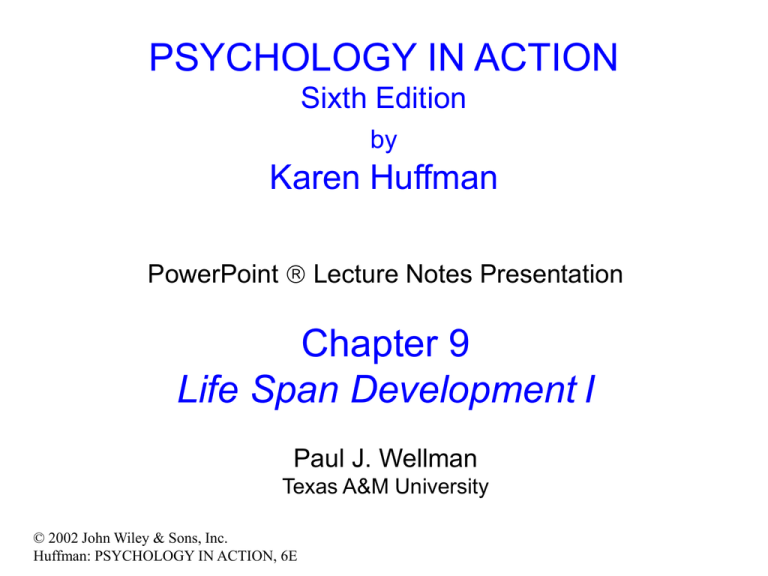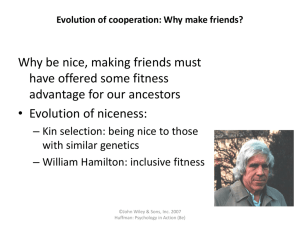
PSYCHOLOGY IN ACTION
Sixth Edition
by
Karen Huffman
PowerPoint Lecture Notes Presentation
Chapter 9
Life Span Development I
Paul J. Wellman
Texas A&M University
© 2002 John Wiley & Sons, Inc.
Huffman: PSYCHOLOGY IN ACTION, 6E
Lecture Overview
•
•
•
•
•
Studying Development
Physical Development
Language Development
Social-Emotional Development
Cognitive Development
© 2002 John Wiley & Sons, Inc.
Huffman: PSYCHOLOGY IN ACTION, 6E
Developmental Psychology
• The focus of developmental psychology
is on age-related changes in behaviors
throughout the life span
• Key development issues include:
– Nature versus nurture?
• To what extent are behaviors the result of
experience or the result of biological processes
such as maturation?
– Stability versus change?
• To what extent are behaviors constant over the
life span?
© 2002 John Wiley & Sons, Inc.
Huffman: PSYCHOLOGY IN ACTION, 6E
• Key Developmental Issues continued
– Continuity versus stages?
• Continuity view suggests that change is uniform
and gradual
• Stage theory suggests that change can be rapid
with qualitatively different stages evident across
the life span
© 2002 John Wiley & Sons, Inc.
Huffman: PSYCHOLOGY IN ACTION, 6E
Life Span Development
Stage
Approximate Age
Prenatal
Infancy
Early childhood
Middle childhood
Adolescence
Young adulthood
Middle adulthood
Later adulthood
Conception to birth
Birth to 18 months
18 mo. to 6 years
6-12 years
12-20 years
20-45 years
45-60 years
60 years to death
© 2002 John Wiley & Sons, Inc.
Huffman: PSYCHOLOGY IN ACTION, 6E
Developmental Research Methods
© 2002 John Wiley & Sons, Inc.
Huffman: PSYCHOLOGY IN ACTION, 6E
Cohort Issues
• Cross-sectional
studies examine
age-related
changes across
different cohorts
• Longitudinal
studies follow the
same cohort
across time
© 2002 John Wiley & Sons, Inc.
Huffman: PSYCHOLOGY IN ACTION, 6E
Culture and Development
• Culture is an important determinant of
development
• Human development has to be studied
within a sociocultural context
• Culture is invisible to its participants
• The beliefs of a culture are key
determinants of behavior within that
culture
© 2002 John Wiley & Sons, Inc.
Huffman: PSYCHOLOGY IN ACTION, 6E
Prenatal Development
• Prenatal development
occurs in 3 stages:
– Ovulation to implantation:
the ovum travels down the
fallopian tube, is fertilized by
a sperm, and is then
implanted within the wall of
the uterus
– Embryonic period:
implantation to 8 weeks
– Fetal stage: 8 weeks to
birth
© 2002 John Wiley & Sons, Inc.
Huffman: PSYCHOLOGY IN ACTION, 6E
Prenatal Hazards
• Teratogens are environmental substances that
can cause birth defects in the developing fetus
– Maternal alcohol use leads to fetal alcohol syndrome
(facial defects, low IQ,neurobehavioral defects)
– Nicotine exposure leads to premature birth, low birth
weight, and more fetal deaths
– These drugs cross the placental barrier and impair
fetal brain development
• Poor maternal nutrition can impair fetal
development
• Drug use by father can damage sperm
– Alcohol, opiates, cocaine, lead, and various gases are
known to damage sperm
© 2002 John Wiley & Sons, Inc.
Huffman: PSYCHOLOGY IN ACTION, 6E
Body Proportions Change
over the Life Span
© 2002 John Wiley & Sons, Inc.
Huffman: PSYCHOLOGY IN ACTION, 6E
Motor Milestones
• Early motor actions of the infant are
limited to reflexes
• Myelination and further brain
development allow for crawling and then
walking
© 2002 John Wiley & Sons, Inc.
Huffman: PSYCHOLOGY IN ACTION, 6E
Perceptual Abilities at Birth
• Infant vision is poor at birth (equivalent to
20/200 to 20/600)
• Functionality of other sensory systems:
– Hearing is functional prior to birth
– Smell is functional at birth
– Touch and pain are functional at birth
• Infant perception can be inferred by changes
in heart rate upon stimulus exposure or by
changes in sucking rate
© 2002 John Wiley & Sons, Inc.
Huffman: PSYCHOLOGY IN ACTION, 6E
Language Development
• Newborns communicate via crying
– Basic hunger cry, anger cry, pain cry
•
•
•
•
•
Cooing starts at 2 months
Babbling appears at about 6 months
Single words appear at one year of age
By age 2, telegraphic speech is evident
By age 5, children have mastered grammar and
have a 2000 word vocabulary
© 2002 John Wiley & Sons, Inc.
Huffman: PSYCHOLOGY IN ACTION, 6E
Social-Emotional Development
• Attachment is defined as an active, intense,
emotional relationship between 2 people that
endures over time
• Attachment as an innate process:
– Bowlby argued that infants have verbal (cooing) and
nonverbal (smiling, following) responses that elicit
nurturance
• Attachment as “contact comfort”
– Harlow found that infant monkeys preferred contact
with terry cloth surface over access to food
© 2002 John Wiley & Sons, Inc.
Huffman: PSYCHOLOGY IN ACTION, 6E
Types of Attachment
• Ainsworth found 3 distinct categories of
attachment evident in children in a strange
situation:
– Secure attachment: infant stays close to mother,
shows moderate distress when separated, and is
happy when mother returns
– Avoidant: Infant does not seek contact with mother
and does not cry when she leaves
– Anxious/Ambivalent: infant is upset when mother
leaves and angry when she returns
© 2002 John Wiley & Sons, Inc.
Huffman: PSYCHOLOGY IN ACTION, 6E
Parenting Styles
• Baumrind studied parenting style:
– Authoritarian: Parent places a high value on
obedience as well as respect for authority
– Permissive: Parent imposes minimal controls on their
children
– Authoritative: Parent enforce standards, but
encourages verbal give-and-take with the child
• Parenting style affects children’s behavior
– Authoritarian parents produce children with low
independence, low self-esteem, and an external locus
of control
• Or, children’s temperament/characteristics may
lead to parental style
© 2002 John Wiley & Sons, Inc.
Huffman: PSYCHOLOGY IN ACTION, 6E
Piaget and Cognition
• Cognitive reasoning is primitive at birth and
changes from infancy to adulthood
• Schemas are the basic units of intellect
• Cognitive adaptation reflects the actions of two
complementary processes:
– Assimilation allows an existing schema to adapt to
the environment
– Accommodation allows the schema to change in
order to handle a new environmental situation
© 2002 John Wiley & Sons, Inc.
Huffman: PSYCHOLOGY IN ACTION, 6E
Cognitive Development Stages
• Sensorimotor period: Birth through age 2
– Infant schemes are simple reflexes and interactions with
people and objects
• Preoperational period: Age 2 to 7
– Child begins to use mental representations, but problem
solving is limited
• Concrete operations: Age 7 to 11
– Child performs mental operations (conservation)
• Formal operations: Age 12 through adulthood
– Child can use formal problem solving and higher level
abstract thinking
© 2002 John Wiley & Sons, Inc.
Huffman: PSYCHOLOGY IN ACTION, 6E
Conservation
• Conservation is the ability to
recognize that a given
quantity, weight or volume
remains the same despite
changes in shape, length, or
position
© 2002 John Wiley & Sons, Inc.
Huffman: PSYCHOLOGY IN ACTION, 6E
Achievement in Late Adulthood
© 2002 John Wiley & Sons, Inc.
Huffman: PSYCHOLOGY IN ACTION, 6E
Copyright
Copyright 2002 by John Wiley & Sons, Inc., New York,
NY. All rights reserved. No part of the material protected
by this copyright may be reproduced or utilized in any
form or by any means, electronic or mechanical,
including photocopying, recording, or by any information
storage and retrieval system, without written permission
of the copyright owner.
© 2002 John Wiley & Sons, Inc.
Huffman: PSYCHOLOGY IN ACTION, 6E





